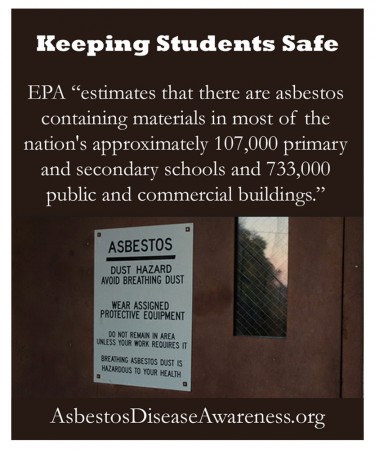Posted on June 24, 2014
Last year, the UK Health and Safety Executive (HSE) began an “inspection initiative in schools outside of local authority control.” We can all learn from the “HSE: Asbestos in Schools” investigation and report to ensure the safety of students and staff.
In 1986, the United States signed the Asbestos Hazard Emergency Response Act (AHERA) legislation into law, requiring “local educational agencies to inspect their school buildings for asbestos-containing building material, prepare asbestos management plans and perform asbestos response actions to prevent or reduce asbestos hazards.” AHERA also tasked the EPA with “developing a model plan for states for accrediting persons conducting asbestos inspection and corrective-action activities at schools.” The EPA states that “one study estimated that 3,000 different types of commercial products contained asbestos. Many older plastics, paper products, brake linings, floor tiles and textile products contain asbestos, as do many heavy industrial products such as sealants, cement pipe, cement sheets, and insulation. It is still legal to manufacture, process and import most asbestos products.”[2] The UK’s “The Control of Asbestos Regulations 2012” (CAR) soundly places duties on those who have responsibilities for the maintenance of work premises, including schools, to manage the risk from asbestos. “The HSE inspectors visited a total of 153 schools – 131 in England, 11 in Scotland and 11 in Wales and released their findings and key messages to help all schools manage the risks from asbestos-containing materials (ACMs). The majority of schools that were inspected (71%) required either no further action or were given straightforward advice. However, 44 schools (29%) received written advice, with enforcement action taken in 20 of these schools (13%) – an Improvement Notice was served on each of these 20 schools.” Some of the key HSE findings include: Click here to read the full “Asbestos Compliance in non-LA Managed Schools“ report. I urge you to join ADAO’s efforts to protect public health and asbestos victims’ civil rights. As we know, “together, change is possible.” Linda [1] http://www2.epa.gov/asbestos/asbestos-laws-and-regulations#ahera [2] http://www.epa.gov/region6/6pd/asbestos/asbgenl.htm  Each day, 30 Americans die from preventable asbestos-caused diseases and without a ban, asbestos exposure and imports continue. The United States Environmental Protection Agency (EPA) “estimates that there are asbestos containing materials in most of the nation’s approximately 107,000 primary and secondary schools and 733,000 public and commercial buildings.”
Each day, 30 Americans die from preventable asbestos-caused diseases and without a ban, asbestos exposure and imports continue. The United States Environmental Protection Agency (EPA) “estimates that there are asbestos containing materials in most of the nation’s approximately 107,000 primary and secondary schools and 733,000 public and commercial buildings.”
